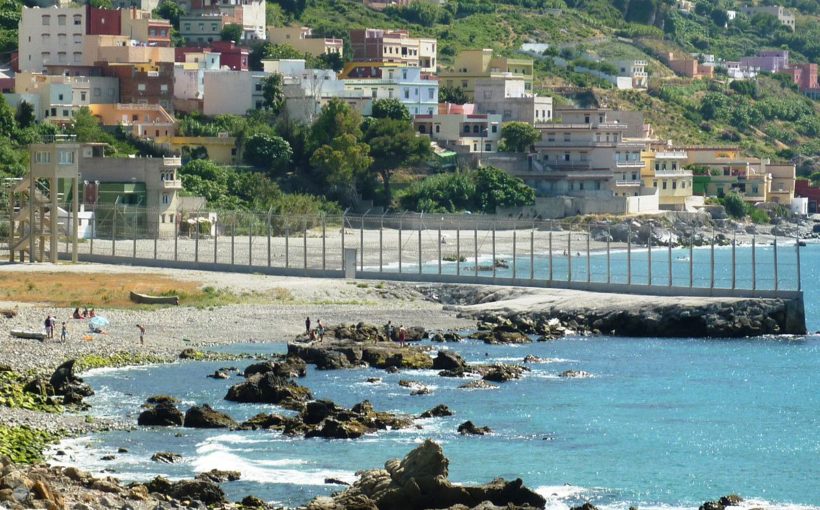If you zoom in to Morocco, you'll see a tiny wedge of land that stands out from its surroundings.
把这个地图放大,放大到摩洛哥这个位置,你就会看到一小块与周围格格不入的楔形土地。
This little bit of land is surrounded by one of the most fortified borders on the planet.
环绕这一小块土地的是世界上最戒备森严的边界。
Right outside the border you'll find makeshift forest camps,
边界外的树林里有一个临时营地,
where people spend their days and nights evading the police and preparing to rush the border,
大家就在这里躲避警察,并为冲过边境线做准备,
usually in large groups, with hopes of jumping over and stepping foot on this land.
他们往往都是一大群一大群地往边境上冲,希望能翻过去,踏上对面的土地。
This peculiar scene plays out because this piece of land, while in the continent of Africa, is actually a piece of Europe.
之所以会上演这奇特的一幕是因为这片土地虽然地处非洲,实际上却是欧洲的一部分。
This small piece of land is called Melilla.
这一小块土地就是“梅利利亚”。
It's one of two Spanish enclaves in Morocco, marking the only borders that Europe shares with the continent of Africa.
它是摩洛哥境内的两块西班牙飞地中的一块,也是欧洲与非洲大陆唯一的交界点。
Spain conquered Melilla in the late 1400s as part of its rapid global expansion.
14世纪末,正在飞速进行全球扩张的西班牙征服了梅利利亚。
This region of northern Africa changed hands many times over the following decades, but Spain kept hold of Melilla.
之后的几十年里,位于北非的这一地区多次易主,梅利利亚却一直没有脱离西班牙的掌控。
Even in 1956, when the colonial period was winding down and great powers were ceding their colonies,
即使是到了1956年,殖民时代逐渐结束,列强纷纷让出殖民地,
Morocco had just declared independence, but even then Spain held onto its enclave.
摩洛哥也宣布独立了,但即便如此,西班牙也没有放手它的这块飞地。
Today, around 86,000 people live in Melilla and when you're there, you might as well be in mainland Spain.
今天的梅利利亚人口在8.6万左右,来到这里之后,你很有可能会有种身在西班牙大陆的感觉。
The city is designed with the distinctive Spanish architectural style and residents speak Spanish.
这座城市的建筑就有着鲜明的西班牙风格,居民们说的也是西班牙语。
They pay in Euros.
用的钱也是欧元。
You're only reminded that you're not in mainland Europe when you walk to the peripheries of this city,
你只有一个时刻会意识到你并不在欧洲大陆,那就是当你走到这座城市的边缘,
to find one of the most fortified border walls on the planet.
去探索世界上戒备最为森严的边境墙之一的时候。
A seven mile barrier with layers of protection.
这是有着层层保护,绵延7英里的一处边境墙。
The first layer is a 20-foot metal fence, followed by a second fence with a flexible top, which makes it harder to climb.
第一层是一道20英尺(约6m)高的金属栅栏,接着是顶部非常柔软,因此也更难翻越的另一道栅栏。
Below this second fence you have barbed wire netting, strong and dense webs,
第二道栅栏下面还有带刺的铁丝网,非常结实而且密集的铁丝网,
then comes another taller fence with a flexible top section and more barbed wire.
再然后是一道更高,也有柔软顶板和带刺铁丝网的栅栏。
Then you're on the Moroccan side
第三道栅栏之后就是摩洛哥这边的边境线了,
where you have a 6.5 foot ditch and then a double fence with you guessed it, more barbed wire.
这边有一条6.5英尺(约2m)高的沟,还有一个带,你猜对了,就是带刺铁丝网的双层栅栏。
There are lookout posts and every inch of the border is monitored by video surveillance.
这一带有瞭望站,边境的每一个角落也都装了监控录像。
To understand why this barrier exists,
要想理解他们为什么会搞一个这么多层的边境墙,
you have to cross over into the Moroccan town of Nador and then into the forest in the hills surrounding the enclave.
我们必须跨过这道边境墙到摩洛哥的纳多镇,再到飞地周围小山中的森林里去寻找答案。
These migrants are mostly from sub-Saharan Africa and they all have different motives for leaving their homelands.
这些移民大多来自撒哈拉以南的非洲,他们离开故土的理由各式各样。

They gather in these camps and plan for the day when they'll try to cross into Melilla.
但他们还是不约而同地来到了这片营地,为穿越到梅利利亚的那一天做准备。
In response to this intense security,
为了突破高度戒备的边境防卫,
the migrants have developed a technique that relies on overpowering the border guards with strength of numbers.
移民们制定出了一种用人海战术压倒边防卫兵的策略。
The groups range in size, but are nearly always in the hundreds.
他们的团伙规模不一,但基本都在几百人左右。
Most get caught right away on the Moroccan side where they face border agents who are not shy about using force.
大部分人还在摩洛哥一侧就已经被抓起来了,那时,他们要面对的就是不会不好意思动武的边境特工了。
Those who make it past the first few layers onto the Spanish section of the barrier are also thrown back immediately or detained,
那些通过了前几层障碍,成功突破到了西班牙一侧的隔离墙下的人也会被立即扔回来,甚至是被拘留,
but because of their large numbers, a few will inevitably slip past the guards.
但由于人数众多,难免还是会有那么几个能从警卫手下溜走的。
As soon as they put their feet on the ground in Melilla,
严格来说,一踏上梅利利亚的土地,
they are technically in Europe and are guaranteed certain protections under European Union law.
这些人就已经在欧洲境内了,根据欧盟的法律,他们也是受到了一定法律保护的。
But they still have to run a hundred meters to an immigration center,
但他们还要再跑一百米,
where they can be taken in and given protection from immediate deportation.
跑到能够接收他们,保护他们不被驱逐出境移民中心才算安全。
Arrivals to these enclaves came to a head in 2014,
抵达这些飞地的人数曾在2014年达到了一个高峰,
when Spain decided it was finally time to double down on its effort to fortify this border.
当时,西班牙刚刚作出决定:是时候给这条边境线上个双保险了。
This was mainly in response to the influx of migrants attempting to get into Europe, fleeing from conflicts in Africa and the Middle East.
这一决定主要是为了对付企图逃离非洲和中东的冲突,到欧洲谋生的大批移民。
"Biggest wave refugees in modern history."
“现代史上最大规模的难民潮。”
"hundreds of thousands of refugees..."
“数十万难民……”
"fleeing brutal violence in the Middle East..."
“逃离中东残酷的暴力……”
"cross over European borders by the hundreds of thousands..."
“几十万人越过欧洲边界……”
"in overcrowded boats, many drowning along the way..."
“在人满为患的小船上,不少人都已经在途中溺水身亡……”
Spain's response to this migration crisis was to focus on the borders of its enclaves in Africa,
面对这场移民危机,西班牙将工作重点放在了其非洲境内的飞地的边境上,
redoubling the efforts to keep migrants out of this little slice of Europe.
为了将移民挡在欧洲这一小块土地之外,他们付出了双倍于以往的努力。
The year after the 2014 migration crisis, attempts to jump the fence dropped by 67%.
2014年移民危机后的第二年,翻越围栏的人立即减少了67%。
Spain didn't make these numbers drop on their own.
不过,这一数字的减少并不是西班牙一个人的功劳。
One of the things you'll notice when you look at this wall, is that Moroccan military and police are also guarding this border.
看着这道墙你会发现,摩洛哥也有军队和警察在守卫这条边境。
The year of the migration crisis, Morocco built these two extra layers of barbed wire fencing.
移民危机爆发的那一年,摩洛哥就在原来的边境墙外加设了两层刺铁丝网栅栏。
"But authorities say dense new anticlimb mesh stopped the latest to make the attempt in their tracks."
“然而,当局表示,新增的密集防爬铁丝网阻止了移民们的最新一次尝试。”
So why would Morocco take the responsibility of building a barrier and standing guard at Spain's border?
那么问题来了,摩洛哥为什么要扛起在西班牙边境修建边境墙及站岗的责任呢?
Turns out they have real incentives to do so.
事实证明,他们还真有这么做的理由。












